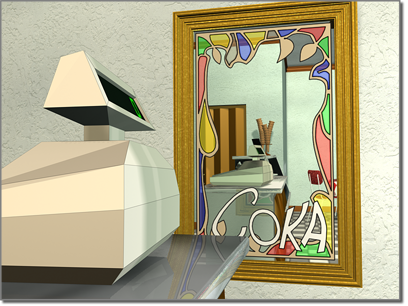If you want to create a flat, mirrored surface in a scene, such as a highly polished floor, you must use a flat mirror reflection map.

Flat mirror map reflects the ice-cream shop's interior.
Flat mirror reflection maps must be assigned to your geometry in a specific way, and work only on flat surfaces.
When you use flat-mirror reflection maps, keep the following in mind:
- The flat-mirror material must be assigned to connected, coplanar faces on a flat surface of the object. If your flat-mirror reflection doesn't work, it's probably because non-coplanar faces have been assigned the flat-mirror material. This can happen during the selection process, if one or more non-coplanar faces are included in the selection set. It can also happen if you've already assigned the same material elsewhere on the object (coplanar faces are two or more adjacent faces that are on the same two-dimensional plane, such as the surface of a floor).
- If you want to reflect in multiple planes of the same object, detach each plane into a separate object before you assign the material.